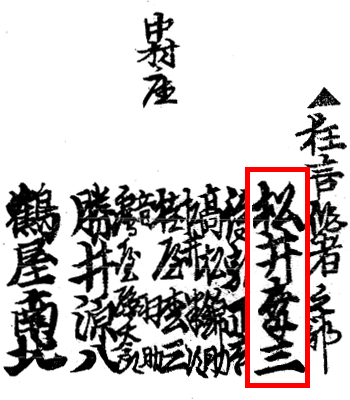| MATSUI KÔZÔ II |
|
Playwright names:
Other name:
Line number: NIDAIME (II) Existence: 1793 ~ 11th day of the 4th lunar month of 1830 [1] Connection: Masters: Tsuruya Nanboku IV, Matsui Kôzô I Disciple: Matsukawa Hôsaku Career: 1793 ~ 1810: born in Edo. He started his career as a shamisen player and his stage name was Kineya Wazô. He became disciple of the sakusha Matsui Kôzô I and received the name of Matsui Shinkô. 11th lunar month of 1810: Shinkô worked at the Nakamuraza, along with Nagawa Tokusuke I (tatesakusha), his master Matsui Kôzô I and Hon'ya Sôshichi, on the kaomise drama "Yuki to Tsuki Hana no Kuronushi". 1815: his master Matsui Kôzô I retired from the Kabuki world. 11th lunar month of 1816: he took the name of Matsui Kôzô II. 11th lunar month of 1817: Kôzô worked at the Miyakoza, along with Tsuruya Nanboku IV and Shinoda Kinji I, on the kaomise drama "Muro no Ume Hôgan Biiki" [6], which celebrated the shûmei of the minor actors Arashi Sanpachi II, Matsumoto Kingo I and Onoe Kôzô I. 11th lunar month of 1819: Kôzô worked at the Tamagawaza, under the command of the tatesakusha Tsuruya Nanboku IV, on the kaomise drama "Nana Komachi Yagura no Amagoi", which welcomed in Edo the Kamigata actors Fujikawa Tomokichi II and Nakayama Tatezô II, and celebrated the shûmei of both Sawamura Tôjûrô I and Fujikawa Tomokichi II; The two stars of this program were Onoe Kikugorô III and Ichikawa Danjûrô VII. 11th lunar month of 1821: premiere at the Kawarasakiza of Tsuruya Nanboku IV's drama "Imoseyama Hitome Senbon", which mixed the "Yoshitsune Senbon Zakura" and "Imoseyama Onna Teikin" worlds [casting]. Others main sakusha were Oto Usuke I, Matsui Yûsuke II and Kôzô. 1st lunar month of 1822: Kôzô worked in the same theater on the new year sogamono drama "Midori no Hana Harutsuge Soga". 11th lunar month of 1822: Kôzô worked at the Ichimuraza, along with Tsuruya Nanboku IV, Segawa Jokô II, Oto Usuke I, Matsui Yûsuke II and Hanagasa Rosuke, on the kaomise drama "Gohiiki Tsuwamono no Majiwari", which welcomed back Iwai Hanshirô V in Edo and celebrated the shûmei of Nakayama Kinsha. 3rd lunar month of 1823: premiere at the Ichimuraza of Tsuruya Nanboku IV's drama "Ukiyozuka Hiyoku no Inazuma" [casting]. Kôzô was a member of the group of sakusha who supported Tsuruya Nanboku IV. 6th lunar month of 1823: premiere at the Moritaza of Tsuruya Nanboku IV's drama "Kesakake Matsu Narita no Riken", starring Onoe Kikugorô III and Ichikawa Danjûrô VII in the roles of Kasane and Yoemon. Kôzô played an important contributor in the writing of the michiyuki, which was entitled "Iro Moyô Chotto Karimame" [2]. 11th lunar month of 1823: Kôzô worked at the Nakamuraza, along with Segawa Jokô II and Katsui Genpachi, on the kaomise drama "Kaeri Giso Kiku no Hitomure". 11th lunar month of 1824: Kôzô became tatesakusha and worked at the Kawarasakiza, along with Tsuruya Nanboku IV, Matsui Yûsuke II and Katsui Genpachi [3], on the kaomise drama "Otokoyama Toritate Genji". 11th lunar month of 1825: Kôzô worked at the Ichimuraza, along with Sakurada Jisuke II and Tajima Konosuke I, on the kaomise drama "Azuma Dairi Kabuki no Shôgatsu". 11th lunar month of 1826: Kôzô worked at the Nakamuraza, along with Tsuruya Nanboku IV, Katsui Genpachi and Matsuchi Shôkichi, on the kaomise drama "Kaeribana Genji no Kachidoki". 11th lunar month of 1827: Kôzô worked at the Kawarasakiza, along with Tsuruya Nanboku IV, Shinoda Kinji II, Tsuruya Magotarô IV and Tajima Konosuke I, on the kaomise drama "Muro no Ume Hôgan Biiki" [6]. 21st day of the 8th lunar month of 1828 [4]: his master Matsui Kôzô I died in Edo. 11th lunar month of 1829: Kôzô worked at the Ichimuraza, along with Matsushima Hanji III, Nagawa Motosuke and Tsuchii Hyôshichi II, on the kaomise drama "Chijinyû Koko-ni Yorimitsu". 3rd lunar month of 1830: premiere at the Nakamuraza of Kôzô's 9-role hengemono "Minokoshite Haru no Kokonoe"; Nakamura Shikan II performed all the roles, including the Yashima Court Lady [5]. 11th day of the 4th lunar month of 1830 [1]: Kôzô died in Edo. Comments: Matsui Kôzô II was an Edo sakusha, who worked on more than 30 dramas from the beginning of the 1810s to 1830. [1] The 11th day of the 4th lunar month of the 13th year of the Bunsei era was the 1st of June 1830 in the western calendar. [2] This michiyuki is still part of the current repertoire and is commonly called "Kasane". [3] Katsushika Otosuke was also part of the group of supporting sakusha (first participation in a kaomise drama). [4] The 21st day of the 8th lunar month of the 11th year of the Bunsei era was the 29th of September 1828 in the western calendar. [5] This role is still part of the current Kabuki repertoire and its current title is "Kanjo". [6] Another possible reading of this title could be "Muro no Ume Hangan Biiki". This drama was premiered in the 11th lunar month of 1817 at the Miyakoza.
The name of Matsui Kôzô II in a 1827 Edo hyôbanki (the name within the red box) The Matsui Kôzô line of playwrights |
|
|
| Contact | Main | Top | Updates | Actors | Plays | Playwrights | Programs | Links | FAQ | Glossary | Chronology | Illustrations | Prints | Characters | Derivatives | Theaters | Coming soon | News |
